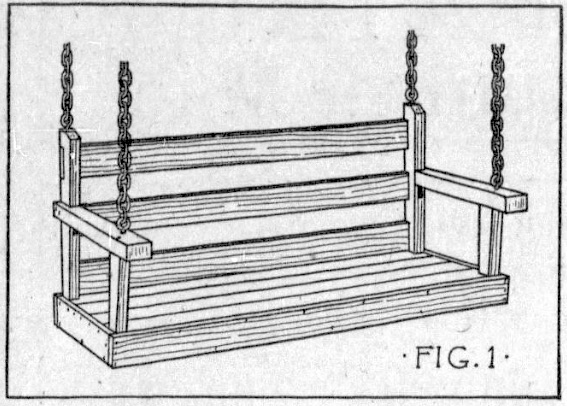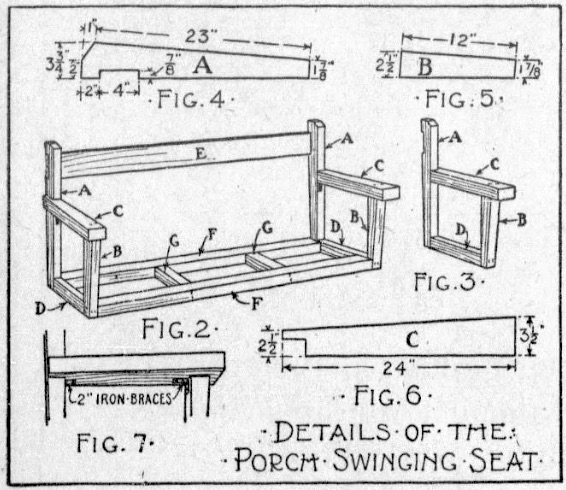
Build an old-fashioned swinging seat for the porch. The instructions and illustrations below were originally printed in 1912.

A Swinging Seat For The Porch
A swinging seat is much more comfortable to sit in than a hammock, makes a neater appearance upon a porch, and with several pillows thrown upon it, will be fully as satisfactory to lie down upon. Fig. 1 shows a seat of an attractive design that can be carried out with ease by any boy who is handy with tools. Oak is the best material to use as it is strong and easily worked; but if you can get nothing but pine it will serve your purpose provided the pieces are free from knots and other defects.
The seat illustrated is 5 feet long and 22 inches wide. If you wish a seat of different proportions, these dimensions are readily varied, of course. The two ends should be constructed first. Material 2 inches thick should be used; 2 by 4s will do. Cut the uprights A by the pattern shown in Fig. 4, uprights B by the pattern in Fig. 5, the arm C by the pattern of Fig. 5, and the bottom crosspiece D 18 inches long by 1-3/4 inches wide. The notch in the rear edge of uprights A is made to receive the ends of the back strip E, and the arms C are notched to fit around uprights A. The dimensions for the notch in C are not given, because the notch must be beveled to fit the slant of upright A, and for the sake of accuracy the measurements are best taken directly from that piece. The members of the end frames must be fastened together very securely, inasmuch as the entire weight of the seat and its occupants come upon them. Long screws are better than nails for the purpose. The arms should be braced underneath by means of a pair of 2 by 2 inch iron angle brackets, as shown in Fig. 7.

The back board E is 7/8 inch thick, 4 inches wide and 5 feet long, while the other two boards of the back, shown in Fig. 1, are 4 feet 8-1/2 inches long, because they fit between uprights A. The seat rails F are of 2 by 4 inch stuff and are of the same length as the lower back boards; fasten them between the end frames. Fit the cross pieces G between these rails.
Fit a covering of boards upon the top of the seat framework, bringing them out to the outer face of each member, as shown in Fig. 1; then nail a 4-inch strip of board around all four sides to conceal the edges of the boards.
Iron chain and eyes for suspending the seat can be purchased at most hardware stores, and will cost between 10 and 15 cents a foot, according to the size of the links. The lower eyes should be long enough to extend about 2 inches into the seat ends, and the upper eyes should extend an equal distance into a joist of the porch ceiling.
The woodwork of the seat may be finished either with a wood stain, varnish or paint. If the wood is of oak, a stain will bring out the marking of its grain best. Shellac should be applied after the stain has dried, to make it permanent. All nail holes should be driven below the surface of the wood, and all holes should be puttied.
Source: Carroll County democrat. (Huntingdon, Tenn.), 20 Dec. 1912.

